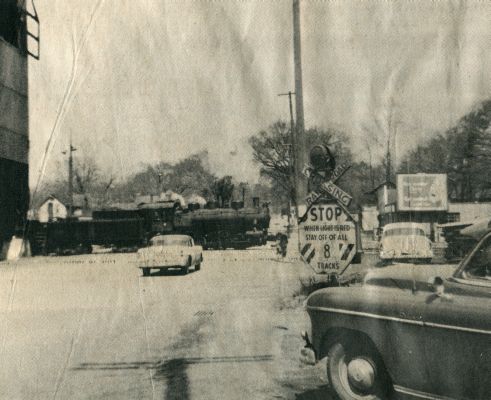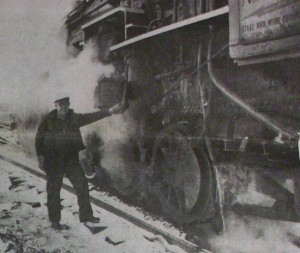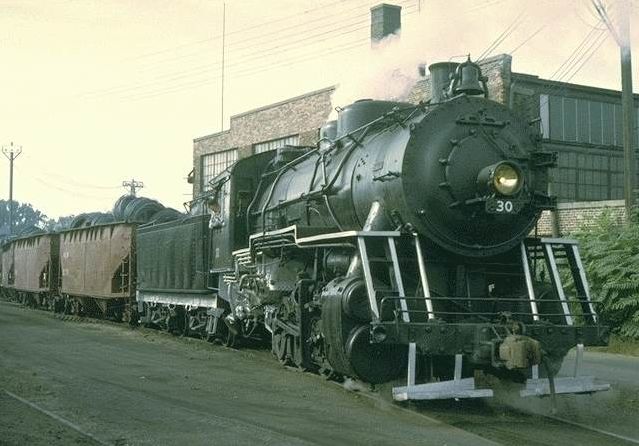Northwestern’s Love Affair for Trains
Story by Ron Parsons – Gazette City Editor ~ 1979
Transcribed, and minor corrections made, by Dana Fellows ~ 2011
Only in Sterling can the grinding, puffing, hissing, rumble and rattle, click and clack sounds of the last of the steam locomotives be heard as they go about the important business of switching the Northwestern Steel and Wire Company cars of steel products and scrap to their destinations.
The fleet of steam locomotives currently used at Northwestern Steel and Wire are the last of a dying breed and perhaps the last of their kind used the United States today (1979). While there are some occasional runs made by steam locomotives owned by museums and “railroad buffs” the steam engine is no longer used and occupies and important chapter in the history of American transportation.

Time was when vehicle traffic stopped for the Northwestern Steel and Wire Company's fleet of steam engines and trains on Avenue G as shown in the photo. This was 1959, or before the overpass was built.
The switch engines currently used at Northwestern operate around the clock on the network of rails encompassing the steel complex. The engines are constantly taking scrap, the basic raw material of the steel industry, to the giant electric furnaces and in turn, hauling the finished product to shipping stations to be in turn, shipped to the actual customer.
The death warrant for the huge steam “work horses” was signed late in the 1930’s when railroads in the U. S. entered a conversion program from the wood and coal-fired steam engines to the powerful petroleum-fired diesel engine. Railroads began this conversion during the late 1930’s and as the years went by; more steam engines were either converted or simply sold for scrap in favor of the popular diesel. It was the beginning of the end for the great steam engine.
It was not until 1960, however, when it was generally recognized as the year the big steam engine died in the United States. The Grand Trunk Western (GTW) ran the last regularly scheduled steam-powered passenger train in February of 1960 and the Illinois-Central and NorthWestern pulled in their last hoppers with 4-8-2’s and 2-8-2’s according to Jim Boyd, in an article published in the spring of 1977.
Shortly after the railroads began their conversion from steam to diesel engines in the late 1930’s the Northwestern Steel and Wire Company initiated the purchase of old locomotives for scrap metal. But, instead of melting them all down, the company decided to use some of them in the plant operation.
Some of the early engines purchased were used for parts and even to the present time, in a certain part is unavailable or obsolete, Northwestern maintains a locomotive repair unit and parts are made here and the engines are kept serviceable and running around the clock.
If, at such time the current Grand Trunk Western class steam engines are taken out of use, or replaced, by Northwestern, it will spell out the final curtain for this very important part of American history. There just aren’t’ any more to be bought,,, at any price.

Photo of Burt Halsne shown shortly before his retirement after 22 years of service with NWSW. He started in 1956 as foreman in the Locomotive and Tractor Repair Department.
In May of 1960, switch engine ex-GTW 0-8-0 8327 (built by Lima in April of 1927 and still in use by NSW), was rounding out its first month of service for the Northwestern Steel and Wire Company It was the first of many engines that would replace the company’s 0-6-0’s.
As late as 1962, Northwestern had more than 100 old steam engines in its scrap yards. Most ended up as the basic raw material in steel-making. Were melted down,,, and finally marketed in the form of nails, fence, bale ties, wire and steel structural pieces.
Not only did Northwestern melt down a number of locomotives, but railroad Pullman and baggage cars were also cut up for the scrap material needed. At one time, a special sale was offered to the public and townsfolk as well as curio collectors from the area purchased light fixtures, furniture and other items from the old cars.
NSW Roster
At its peak, Northwestern had a total of 16 ex-Great Trunk Western 0-8-0 engines and as near as can be determined, all but two (8310 and 8314) were actually steamed up for service at one time or another. Several years before the GTW’s arrived, the biggest engine used by Northwestern for switching was an 0-60 wheel configuration which the Chicago Burlington & Quincy Railroad had converted from 2-6-2 model. This unit was the NS&W’s first oil burner and served off and on until the 0-8-0’s arrived.
With the current fleet of some 16 engines to work from, Northwestern keeps approximately four serviceable at any given time and with a storehouse full of parts salvaged from 20 years scrappeing steam locomotives, the company is much better equipped than most to keep them running economically.
With the recent innovations of oil firing and the auxiliary tenders, the current engines are easily on-man engines keeping in mind that even with the use of coal earlier, the engineer did his own firing. Under the old coal fired system, Northwestern engines are reported to have consumed approximately 24 tons of coal each day along with 48,000 gallons of water. As far as peer is concerned, a GTW 0-8-0 engine is able to tie onto over 25 loads of steel, work up their steam, and move them down the track.
Northwestern Steel and Wire Chairman of the Board, P.W. Dillon has a special admiration for steam locomotives. His admiration for the “iron house” stems from earlier experiences when, as a youth, he operated steam engines while in Colorado for health reasons. It was his decision some years ago to keep the Northwestern steam engines running as long as they could be economically justified.
And while local residents in the Rock River Valley today take the huffing and puffing Northwester steam engines as a common-place activity, rail-fans from the state and other states as well, consider it as distinct privilege to travel to Sterling to witness again, the thrill and excitement of the old steam locomotives in action… a living legend today and still adding pages to the history of tat important chronicle… the American railroad.

